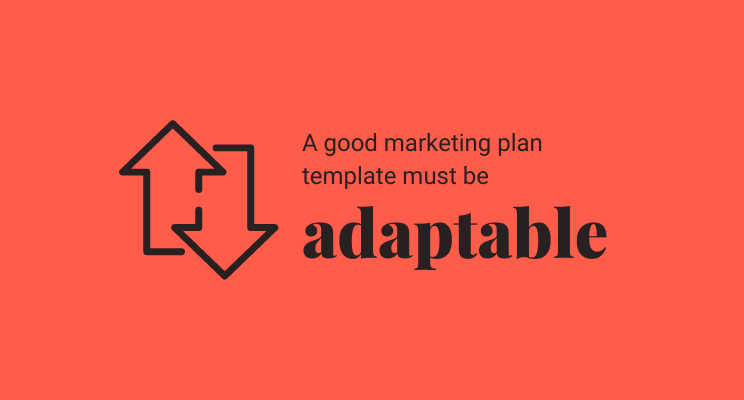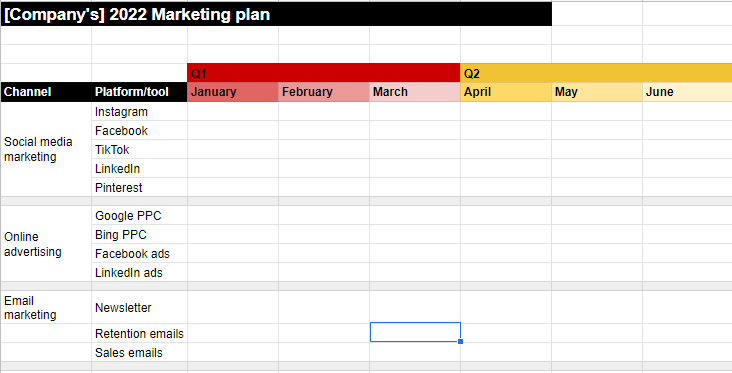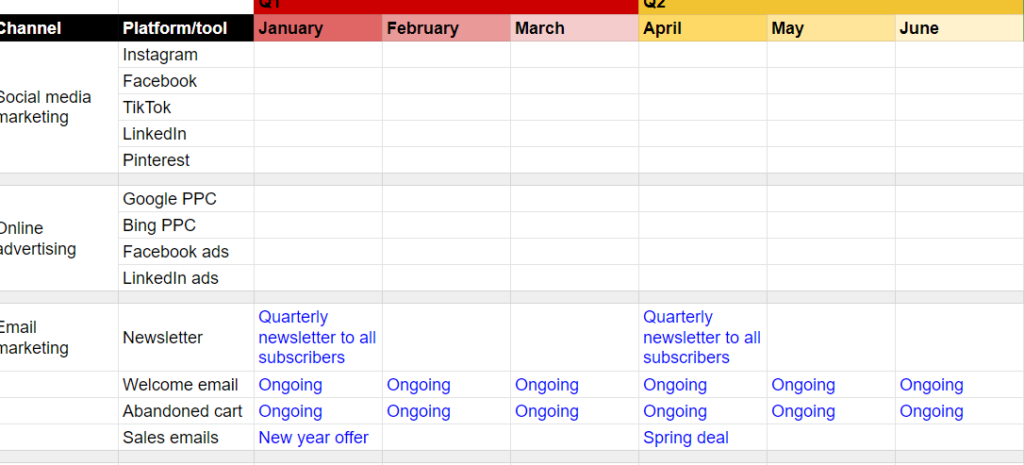Are you looking for a few simple tips to give your existing marketing template a little boost? In our recent blog on how to build a simple yet effective marketing plan, we talked extensively about what makes a good marketing plan. A marketing plan is a working document that details:
- Where your busines currently stands
- Where you’d like your business to be
- Your plans for achieving your objective(s)
Your marketing plan is never set in stone. In fact, your business priorities are subject to change due to many internal and external factors. For example, a shift in your client’s needs/tastes or new trends being developed in your industry. Or again, a change in the political, economic and social landscape. All these elements can have a major impact on your business over time (think about Covid19 or the current war in Ukraine).

A good marketing plan template must be easily adaptable. It needs to give you the flexibility you need to quickly/easily update your upcoming tasks and keep your business on track to achieve your objectives.
Why does a business need a marketing plan?
It takes time and energy to fill in your first marketing plan template, we get it. So, why should you spend time working on a plan that will inevitably change over time? Your business needs a marketing plan for many, many reasons. For example, it helps you:
- Identify your SMART goals (Specific, Measurable, Achievable, Relevant, Time-framed).
- Have a clear roadmap of activities to implement throughout the year.
- Keep the focus on specific marketing activities that will help you achieve your objectives.
- Ensure that your marketing activities are relevant and timely.
The purpose of a marketing plan is to allow you to have a clear picture of your ideal customer. Plus, your marketing objectives and a timeline for your business to implement the tactics to help you achieve your goal.
What makes a good marketing plan template?
To have a marketing plan in place, you need to have a good template to start with. If you’ve read our blog post on how to build a simple yet effective marketing plan, then we hope you are already making the most of our marketing plan template. If you haven’t yet, we recommend you go back to this blog post and get started with the basics before proceeding with reading this article.
A good marketing plan template must be able to change with the wind. If your customers’ behaviours change, your company must be able to respond by changing your strategy. In addition to this, if your market/audience tells you that you need more time, your marketing plan should be able to reflect this need.
So, how do you boost a basic marketing plan template?
So, you’ve filled in your marketing plan and all the essential parts and you’re now ready to give your old marketing plan template a boost. Before moving on, make sure you’ve got all the following elements sorted:
- Executive summary
- Marketing personas
- Competitors and market analysis (SWOT)
- Goals and marketing objectives
- KPIs
- Marketing tactics & channels
- Budget
If you haven’t finalised these areas yet and/or you’re unsure where to start from, don’t worry. We can help you map out your marketing priorities and draft a simple plan that works for you. Check out our online, 1-2-1 workshop and book your slot.
Now, let’s dive into our 5 tips to boost a simple marketing plan template.
1. Review your marketing channels
Firstly, think about your marketing objectives. Then think about your marketing personas (your ideal clients). Then review the channels listed in your marketing plan and ask yourself the following questions:
Are the marketing channels you’re using still relevant? Are the people/businesses you’re targeting actively present across those channels? How will you generate demand? What tools/channels should you be using?
Review your marketing plan and focus your efforts on the channels that really matter to you. Keep focusing on the channels where your audience is more likely to be. For example, can you pick your top 3 channels out of the list below?
- Social media
- Your website & SEO
- Email marketing
- Webinars & online events
- Off-line events
- Content marketing (e.g. blogs, whitepapers, co-blogging, guest-blogging, etc.)
- Online advertising (e.g. PPC, Display ads, etc.)
- Influencer marketing
- Traditional media
- Affiliate marketing
- Off-line marketing (e.g. billboards, print, direct mail, etc.)
Remember – less is more.
2. Identify the platforms and the marketing tools you’ll use for each channel
Now, it’s important to decide what marketing mix is best for your business. For example, there are tons of social media platforms and marketing tools out there, but what’s right for your business?
It’s essential to be loyal to your brand personality and identity. Therefore, we recommend picking the platforms and tools that really fit your brand strategy. For example:
What social media platforms used by your target audience are also right for your business? When it comes to email marketing, what type of email should you be sending (e.g. newsletters, sales emails, follow up emails, etc.)? What type of online advertising are you looking to implement?
To give your marketing plan template the boost you’re after, we recommend to:
- Go back to the list of preferred channels you just drafted.
- Expand on your notes and list the platforms/tools you’ll be using moving forwards. For example:
- Social media marketing: Instagram, Facebook, LinkedIn, TikTok, Pinterest, etc.
- Email marketing: monthly newsletters, retention emails, sales emails, etc.
- Online advertising: Google and Bing PPC, Facebook and LinekdIn ads.
And so on…
3. Enhance your marketing plan template
Once you’ve listed your channels and the platforms/tools you’ll be using, it’s time to create a proper timeline. We’d recommend using an Excel or Google spreadsheet to do so. Alternatively, you can download our advanced marketing plan template below!

Try to be as specific as possible. What marketing activities will you run and when?
4. List your key marketing tactics for each platform
Now that you know what platforms you’ll be operating on, it’s time to think about the key marketing tactics you’re looking to implement for each of these channels. For example, let’s dig into your email marketing strategy…

If you’re a B2C company, then you should be sending out weekly (or even biweekly) campaigns. You should set up automatic welcome and follow up emails to engage with people that have signed up for your newsletter or have downloaded a freebie from your website. Are you engaging with people that have abandoned their carts? Having an automated flow for this is essential!
What about your existing customers? How are you nurturing the relationship via email marketing?
5. Work in sprints and milestones
Try not to be too tied to a monthly plan. For example, you should always give yourself the flexibility to respond to unpredictable changes whilst keeping a strong strategic direction.
As shown in our advanced marketing plan template, we recommend breaking up the year (and your marketing plan) into quarters. You can then work on the basis of 90-days sprints and regularly review how you’re doing against your quarterly objectives. This allows you to have the flexibility to respond to small changes whilst still effectively moving towards your strategic goal.
It goes without saying that your quarterly objectives must be tied to your key milestones. Your milestones are strategically crucial events that must be achieved (i.e. product releases, periodic surges in demand or particular events that will yield great value for the business). Keeping the focus on these milestones ensures you’ll always have the right resources at the right time.
For example, when your key event is on the horizon, you can strategically create and distribute content in the lead up to this key milestone. Rather than simply turning up to a conference, you can get your marketing team to build up engagement ahead of the day. This will maximise the return (on investment AND effort) and give you great rewards.
Conclusion
The success of a marketing plan lives and dies with execution.
Therefore, if your marketing plan is based on the following, you should be set up for success:
- A clear, detailed and easy to use marketing plan template. You can download ours here.
- Clear marketing priorities, objectives and metrics to measure your efforts. Book a 1-2-1 workshop session with us to nail this for your business.
- Be structured but flexible.





0 Comments
Trackbacks/Pingbacks